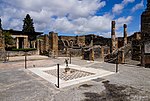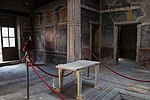House of the Greek Epigrams

The House of the Greek Epigrams (Casa degli Epigrammi Greci, V 1,18) is a Roman residence in the ancient town of Pompeii that was destroyed by the eruption of Mt. Vesuvius in 79 CE. It is named after wall paintings with inscriptions from Greek epigrams in a small room (y) next to the peristyle. The home at the time it was destroyed was the result of merging at least two earlier dwellings dating back to the second half of the second century B.C.E. It is estimated this merger occurred around the third quarter of the first century B.C.E. It is thought further alterations took place in the second half of the first century CE as well. The remains of a staircase at another of the home's entrances, V 1,12, indicate there was once an upper floor over that portion of the house, probably used as an apartment rental. Another staircase was found in the south end of the west portico of the peristyle that appears to be associated with the same service functions as the rooms directly below.
Excerpt from the Wikipedia article House of the Greek Epigrams (License: CC BY-SA 3.0, Authors, Images).House of the Greek Epigrams
Vicolo delle Nozze d'Argento,
Geographical coordinates (GPS) Address External links Nearby Places Show on map
Geographical coordinates (GPS)
| Latitude | Longitude |
|---|---|
| N 40.752134 ° | E 14.485724 ° |
Address
Casa degli epigrammi greci
Vicolo delle Nozze d'Argento
80045
Campania, Italy
Open on Google Maps











